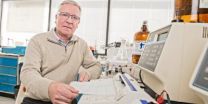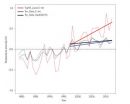(Press-News.org) Stars, diamonds, circles.
Rather than your average bowl of Lucky Charms, these are three-dimensional cell cultures generated by an exciting new digital microfluidics platform, the results of which have been published in Nature Communications this week by researchers at the University of Toronto. The tool, which can be used to study cells in cost-efficient, three-dimensional microgels, may hold the key to personalized medicine applications in the future.
"We already know that the microenvironment can greatly influence cell fate," says Irwin A. Eydelnant, recent doctoral graduate from IBBME and first author of the publication. "The important part of this study is that we've developed a tool that will allow us to investigate the sensitivity of cells to their 3D environment."
"Everyone wants to do three-dimensional (3D) cell culture," explains Aaron Wheeler, Professor and Canada Research Chair in Bioanalytical Chemistry at the Institute of Biomaterials & Biomedical Engineering (IBBME), the Department of Chemistry, and the Donnelly Centre for Cellular and Biomolecular Research (DCCBR) at the University of Toronto. "Cells grown in this manner share much more in common with living systems than the standard two-dimensional (2D) cell culture format," says Wheeler, corresponding author of the study.
But more naturalistic, 3D cell cultures are a challenge to grow. "The reagents are expensive, the materials are inconvenient for automation, and 3D matrices break down upon repeated handling," explains Wheeler, who was named an Inventor of the Year by the University of Toronto in 2012.
Eydelnant was able to address these difficulties by adapting a digital microfluidics platform first created in the Wheeler lab. Cells, caught up in a hydrogel material, are gently flowed across a small field that, on a screen, looks much like a tiny chessboard. The cells are strategically manipulated by a small electric field across a cutout shape on the top plate of the system, made from indium in oxide, and become fixed.
"When we grew kidney cells in these microgels, the cultures formed hollow sphere structures resembling primitive kidneys within four or five days," Eydelnant claims.
The tool allows a great deal of flexibility in terms of the number of different kinds of cells that can be incorporated into the shapes, as well as the shapes and size of the microenvironments: whimsical, like the stars, diamond and circles of Lucky Charms, or designed to mimic living 3D niches, offering researchers a glimpse into how these factors all affect cell fate decisions.
What's more, according to Eydelnant, the platform permits researchers to run, "32 experiments at the same time, automatically, and all on something the size of a credit card."
"[This new] system allows for hands-free assembly of sub-microlitre, three-dimensional microgels. Each gel is individually addressable, fluid exchange is gentler than macro-scale alternatives, and reagent use is reduced more than 100-fold," Wheeler says.
"We believe that this new tool will make 3D cell culture a more attractive and accessible format for cell biology research," he adds.
Although the researchers can foresee numerous possible applications for this platform, the team is "particularly excited" about its potential for personalized medicine.
Wheeler argues, "We may be able to collect small tissue samples from patients, distribute them into 3D gels on digital microfluidic devices, and screen for conditions to identify individually tailored therapies. This is in the 'dream' stages for now, but we think the methods described here will be useful for these types of applications in the future."
INFORMATION:
3-D microgels 'on-demand' offer new potential for cell research
2014-02-26
ELSE PRESS RELEASES FROM THIS DATE:
New gas-phase compounds form organic particle ingredients
2014-02-26
Helsinki/Jülich/Leipzig. Scientists made an important step in order to better understand the relationships between vegetation and climate. So-called extremely low-volatility organic compounds, which are produced by plants, could be detected for the first time during field and laboratory experiments in Finland and Germany. These organic species contribute to the formation of aerosol that can affect climate and air quality, they report in this week's issue of the journal Nature. The results may help to explain discrepancies between observations and theories about how volatile ...
Antidote can deactivate new form of heparin
2014-02-26
Low-molecular-weight heparin is commonly used in surgeries to prevent dangerous blood clots. But when patients experience the other extreme – uncontrolled bleeding – in response to low-molecular-weight heparin, there is no antidote.
Now researchers at the University of North Carolina at Chapel Hill and Rensselaer Polytechnic Institute have created a synthetic form of low-molecular-weight heparin that can be reversed if things go wrong and would be safer for patients with poor kidney function.
"When doctors talk to me about the kind of heparin they want to use during ...
Surge in designer drugs, tainted 'E' poses lethal risks
2014-02-26
In the span of a decade, Canada has gone from ecstasy importer to global supplier of the illegal party drug. At the same time, even newer designer highs—sometimes just a mouse-click away—are flooding the drug market faster than legislation can keep pace.
It's a worrying problem that University of Alberta researchers say requires more education to help Canadians understand the very real, deadly risks of designer drug use.
"The chemists who are making these drugs are coming up with about 10 new drugs per year; the legislation cannot keep up with the market," said Alan ...
Study shows why breastfed babies are so smart
2014-02-26
Loads of studies over the years have shown that children who were breastfed score higher on IQ tests and perform better in school, but the reason why remained unclear.
Is it the mother-baby bonding time, something in the milk itself or some unseen attribute of mothers who breastfeed their babies?
Now a new study by sociologists at Brigham Young University pinpoints two parenting skills as the real source of this cognitive boost: Responding to children's emotional cues and reading to children starting at 9 months of age. Breastfeeding mothers tend to do both of those ...
Still-fresh remnants of Exxon Valdez oil protected by boulders
2014-02-26
HONOLULU – Twenty-five years after the infamous Exxon Valdez oil spill in Prince William Sound, beaches on the Alaska Peninsula hundreds of kilometers from the incident still harbor small hidden pockets of surprisingly unchanged oil, according to new research being presented here today.
The focus of the study is to learn how oil persists long after a spill. Researchers presenting the work caution that the amount of oil being studied is a trace of what was originally spilled and that results from these sites cannot be simply extrapolated to the entire spill area.
The ...
Fox Chase researchers discover new mechanism of gene regulation
2014-02-26
In the cells of humans and other organisms, only a subset of genes are active at any given time, depending largely on the stage of life and the particular duties of the cell. Cells use different molecular mechanisms to orchestrate the activation and deactivation of genes as needed. One central mechanism is an intricate DNA packaging system that either shields genes from activation or exposes them for use.
In this system, the DNA strand, with its genes, is coiled around molecules known as histones, which themselves are assembled into larger entities called nucleosomes. ...
Harvested rainwater harbors pathogens
2014-02-26
South Africa has been financing domestic rainwater harvesting tanks in informal low-income settlements and rural areas in five of that nation's nine provinces. But pathogens inhabit such harvested rainwater, potentially posing a public health hazard, especially for children and immunocompromised individuals, according to a team from the University of Stellenbosch. The research was published ahead of print in Applied and Environmental Microbiology.
International studies had indicated that harvested rainwater frequently harbors pathogens, and that, in light of the financing ...
No warming hiatus for extreme hot temperatures
2014-02-26
Extremely hot temperatures over land have dramatically and unequivocally increased in number and area despite claims that the rise in global average temperatures has slowed over the past 10 to 20 years.
Scientists from the ARC Centre of Excellence for Climate System Science and international colleagues made the finding when they focused their research on the rise of temperatures at the extreme end of the spectrum where impacts are felt the most.
"It quickly became clear, the so-called "hiatus" in global average temperatures did not stop the rise in the number, intensity ...
Beta-catenin alters T cells in lasting and harmful ways
2014-02-26
Activation of beta-catenin, the primary mediator of the ubiquitous Wnt signaling pathway, alters the immune system in lasting and harmful ways, a team of Chicago-based researchers demonstrate in the February 26, 2014, issue of Science Translational Medicine.
An increase in beta-catenin in certain types of T cells—a class of white blood cells—causes chronic inflammation in the intestine and colon, eventually leading to cancer. The same mechanism is used by colon cancer to propagate itself. The researchers combine data from patients suffering from colitis or colon cancer ...
Hubble monitors supernova in nearby galaxy M82
2014-02-26
This is a Hubble Space Telescope composite image of a supernova explosion designated SN 2014J in the galaxy M82. At a distance of approximately 11.5 million light-years from Earth it is the closest supernova of its type discovered in the past few decades. The explosion is categorized as a Type Ia supernova, which is theorized to be triggered in binary systems consisting of a white dwarf and another star — which could be a second white dwarf, a star like our sun, or a giant star.
Astronomers using a ground-based telescope discovered the explosion on January 21, 2014. This ...




